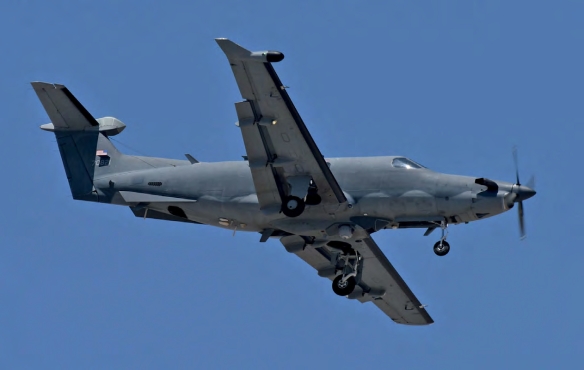
This toned-down camouflage laden PC-12 turboprop is not used to fly business executives around and about. This is a U-28A operated by Air Force Special Operations Command. Two U-28As were present at Nellis during Class 19A WSINT flying missions from the super base to desert strips in the Nevada Test and Training Range
The U-28A is a manned, tactical ISR and targeting platform based on the Pilatus PC-12. It is employed worldwide in support of special operations ground forces, humanitarian efforts, and search and rescue. Mods include advanced radio-comms suite, survivability equipment, EO sensors, and advanced navigation systems. The USSOCOM-owned aircraft are operated by AFSOC as a nonstandard fleet. AFSOC first employed the aircraft during Enduring Freedom in Afghanistan and Iraqi Freedom. The fleet includes 28 operational and eight training aircraft. Two aircraft were lost to fatal mishaps in Djibouti in 2012 and at Cannon in 2017. Ongoing upgrades include sensor, self-defense, remote SIGINT, and navigation mods to enable ops in GPS-degraded environments and comply with Federal Aviation Administration airspace mandates. Multispectral Targeting System installation includes FMV, EO-IR, IR real-time video, and co-aligned laser designator. New Advanced Threat Warning (ATW) includes missile, hostile fire, and laser warning. Urgent infrared suppression mods are ongoing, and Enhanced Ground Proximity Warning will prevent flight-into-terrain accidents. FY20 funds additional U-28 EQ+ mods to enable deployment of four additional high-definition, FMV-equipped aircraft for extended stand-off “find, fix, finish” capabilities in support of counter-ISIS ops. AFSOC officially dubbed the type “Draco” in May 2019, but announced plans to replace the fleet with 75 “armed overwatch” aircraft capable of tactical ISR and light CAS.
The U-28A provides tactical airborne intelligence, surveillance, reconnaissance (AISR) and targeting in support of theater special operations forces (SOF). The non-standard aircraft is based on the single-engine Pilatus PC-12/45. US Special Operations Command acquired an initial batch of six PC-12s from commercial sources in 2005 and they were modified for use in support of Operations `Enduring Freedom’ and `Iraqi Freedom’. The U-28A ‑ fleet is assigned to AFSOC’s light tactical fixed-wing ‑ fleet. It includes 34 U-28As that comprise 28 operational aircraft and eight tasked as training assets. The aircraft are operated by five special operations squadrons at Hurlburt Field, Florida, and Cannon AFB, New Mexico. The U-28A crew is comprised of two pilots, a combat systems officer (CSO) and a tactical systems officer (TSO). Since entering service the platform has ‑ own more than 500,000 hours.
Special operation forces prefer to operate at night for the tactical advantage of executing the mission with speed and surprise before detection by the enemy.
In a recent Operation Coyote mission, 20 units, nearly 30 aircraft and approximately 160 personnel assigned to various commands were vital for the mission to succeed.
Undergraduates assigned to the 14th WPS serve with the various branches of US Special Operations Command who, during WSINT missions get the opportunity to rehearse, for example, the precise, detailed planning required to design and execute an air mission supporting a hostage rescue.
During Class WSINT 19A types involved were HC-130J Combat King IIs, MC-130H Combat Talons, MH-47G Chinooks, HH-60G Pave Hawks and MH-60M Black Hawks.
In addition, two U-28As flew a series of missions during WSINT most likely in support of Operation Coyote. This modified Pilatus PC-12 turboprop is used by Air Force Special Operations Command to provide search and rescue, tactical airborne ISR to humanitarian operations, conventional and special operation missions. The aircraft is fitted with a military radio communication suite with full-motion video and secure voice communications data link capability, advanced navigation systems and electrooptical sensors.
Of the 35 missions staged throughout a WSINT, the 14th WPS participates in approximately one third of them, those that require special operation forces integration to ensure success.
Contractor: Pilatus Aircraft Ltd.
First Flight: May 31, 1991 (PC-12).
Delivered: 2006-N/A.
IOC: June 2006.
Production: 36.
Inventory: 28 (USSOCOM-owned).
Operator: AFSOC, AFRC.
Aircraft Location: Cannon AFB, N.M.; Hurlburt Field, Fla.
Active Variant: U-28A. Special operations variant of the civilian Pilatus PC-12.
Dimensions: Span 53.3 ft, length 47.3 ft, height 14 ft.
Weight: Max T-O 10,935 lb.
Power Plant: Single Pratt & Whitney PT6A-67B, 1,200 shp.
Performance: Speed 253 mph, range 1,725 miles.
Ceiling: 30,000 ft.
Accommodation: Two pilots, CSO, tactical systems officer.